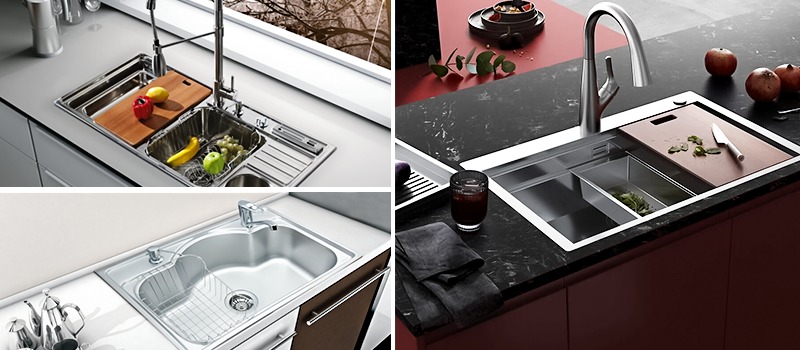Futura Kitchen Sinks, A Perfect Sinks for Your Dream Home
Futura Kitchen Sinks, A Perfect Sinks for Your Dream Home

enhance your cooking experience with modern kitchen sinks
By:
Admin
30th January 2023
a quality kitchen sink is an integral part of any good kitchen setting. it should be multi-functional, durable and of course, look great too.
Finding the best kitchen sink that satisfies your kitchen's needs might seem daunting, but worry not! In this blog we will unpack some kitchen sink ideas, give you much-needed information, and help you find your ideal sink. Let's dive right in and discuss the most popular kitchen sink styles with pros and cons for each one!
1) Top-Mount or Self-Rimming Sink
The top-mount or drop-in kitchen sink, which is the most popular kind, is installed from above. A hole is cut into the counter material, and the sink is fitted from above using a template provided by the sink manufacturer. The rim supports the entire weight of the sink. The silicone is then used to seal the sink's rim to the counter. These sinks are sometimes referred to as rimmed or self-rimming sinks because the edge of the sink forms a rim.
PROS:
Easy installation that you can even do yourself.
Low-cost option.
CONS:
The sink’s rim can be a hassle to clean and be less visually appealing.
2) undermount sink
In contrast to top-mount sinks, undermount sinks use specialised clips to secure the sink to the underside of the counter.
PROS:
Smooth, even countertop that is easy to clean.
Looks better than top-mount sinks.
CONS:
Risk of gunk and food debris collecting around the sink.
Expensive option.
3) Double Basin / Bowl Sink
Double basin kitchen sink configurations, which are the most common, allow for washing on one side and rinsing or drying on the other. Double basin sinks are incredibly versatile and cover all sink functions, including washing, rinsing, and draining. With a good double basin sink, it is difficult to go wrong.
PROS:
Multi-purpose and very flexible.
Works well with houses without a dishwasher.
Cons:
Can be a hassle to wash bigger utensils.
Some people dislike the utilitarian look of the sink.
4) Farmhouse sinks
Farmhouse (apron) sinks and in-counter sinks both fall under the basic category of single-basin kitchen sinks. The basin of this style of sink is not separated.
PROS:
Good to wash bigger utensils.
Ideal for large-capacity houses.
CONS:
You need a separate drying area as there is no provision for it in the sink itself.
Can be small and inconvenient.
5) Drainboard sinks
Sinks with drainboards combine a small basin with a counter-level drainboard on opposite sides.
PROS:
These more compact sinks are ideal for galley kitchens or any place that is constrained.
The drainboard piece has a lip all the way around it, which collects water and allows it to quickly drain back into the sink.
CONS:
Sinks with drainboards typically have small basins. Therefore, if you enjoy cooking and hosting large gatherings, this sink might not be for you.
The drainboard won't be much use if you don't frequently wash dishes by hand.
6) Low Divider Double Basin Sink:
A low divider kitchen sink is a double basin sink, but the divider stops halfway up rather than reaching to the level of the top of the sink.
PROS:
Sinks with low dividers are the ideal fusion of single and double sinks. It functions as a double basin sink when one side is only partially filled with water. However, simply keep filling higher until the water overflows the barrier if you need more space for large pans.
The low divider sink is typically easier to use for food preparation.
CONS:
Low divider sinks aren't offered by many manufacturers, thus their costs are typically greater than those of single basin, double basin, and even farmhouse sinks.
The low divider sink provides less space for big objects like casseroles or broiler pans, even though it can theoretically serve as a single basin sink.
7) Island Sinks:
Bar (or prep) sinks are used either for bartending activities or for supplemental food preparation. They are significantly smaller than basic kitchen sinks. Bar/prep sinks nearly invariably have a single basin and are often no larger than 15 inches in size (round).
PROS:
A second sink, if you have the room, is always appreciated. Install this sink at the far end of your main countertop or in your kitchen island.
It is simpler for numerous persons to prepare food simultaneously when there are additional sinks.
If you frequently entertain and want quick access to a bar sink while cooking or cleaning up following a meal, these sinks are a terrific addition.
CONS:
Despite installing these sinks with the best of intentions, some homeowners seldom ever use them.
The location of supplementary sinks in your kitchen may be an important consideration.
Secondary sinks are a luxury that could unnecessarily blow your budget.
8) Corner Sinks:
Double basins that are positioned at right angles to one another make up a kitchen corner sink.
PROS:
Some corner sinks have enough space between them to provide an integrated drying area in the middle.
Counter corners, a notorious space-waster, are smartly utilised by corner sinks.
CONS:
Corner sinks are uncommon and therefore difficult to find.
Corner sinks are pricey when you can find them.
Additionally, these sinks require certain counter cuts. These sinks are forced to span the corner seam that most kitchen countertops have, which weakens the countertop's structural integrity there.